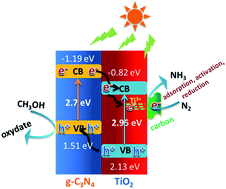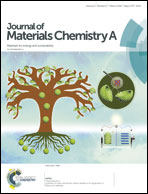MXene-derived TiO2@C/g-C3N4 heterojunctions for highly efficient nitrogen photofixation†
Abstract
Achieving robust catalysis of the nitrogen reduction reaction (NRR) is an ongoing scientific challenge, which needs activation and cleavage of the extremely strong N–N triple bond (bond energy: 940.95 kJ mol−1). The famous Haber–Bosch process requires enormous energy and extreme conditions in the presence of an iron catalyst to achieve the above-mentioned process. Environmentally friendly solar nitrogen fixation at room temperature and atmospheric pressure is an appealing way, but its efficiency is far from satisfactory for industrialization. Herein, we report for the first time on the design and preparation of MXene-derived TiO2@C/g-C3N4 heterojunctions where two-dimensional (2D) planar carbon nanosheet-supported TiO2 is thermally derived from MXene Ti3C2Tx and effectively coupled with in situ formed g-C3N4 nanosheets. Such a structure features abundant surface defects, high electron-donating ability, suitable light harvesting ability, excellent charge transport properties, and strong nitrogen activation ability and is demonstrated to be a robust photocatalyst for the NRR and achieves an NH3 production rate of 250.6 μmol g−1 h−1 under visible light irradiation. This performance compares favorably with those of previously reported photocatalysts for the NRR. The present finding would enrich our knowledge on designing and developing photocatalytically active catalysts for the NRR.



 Please wait while we load your content...
Please wait while we load your content...